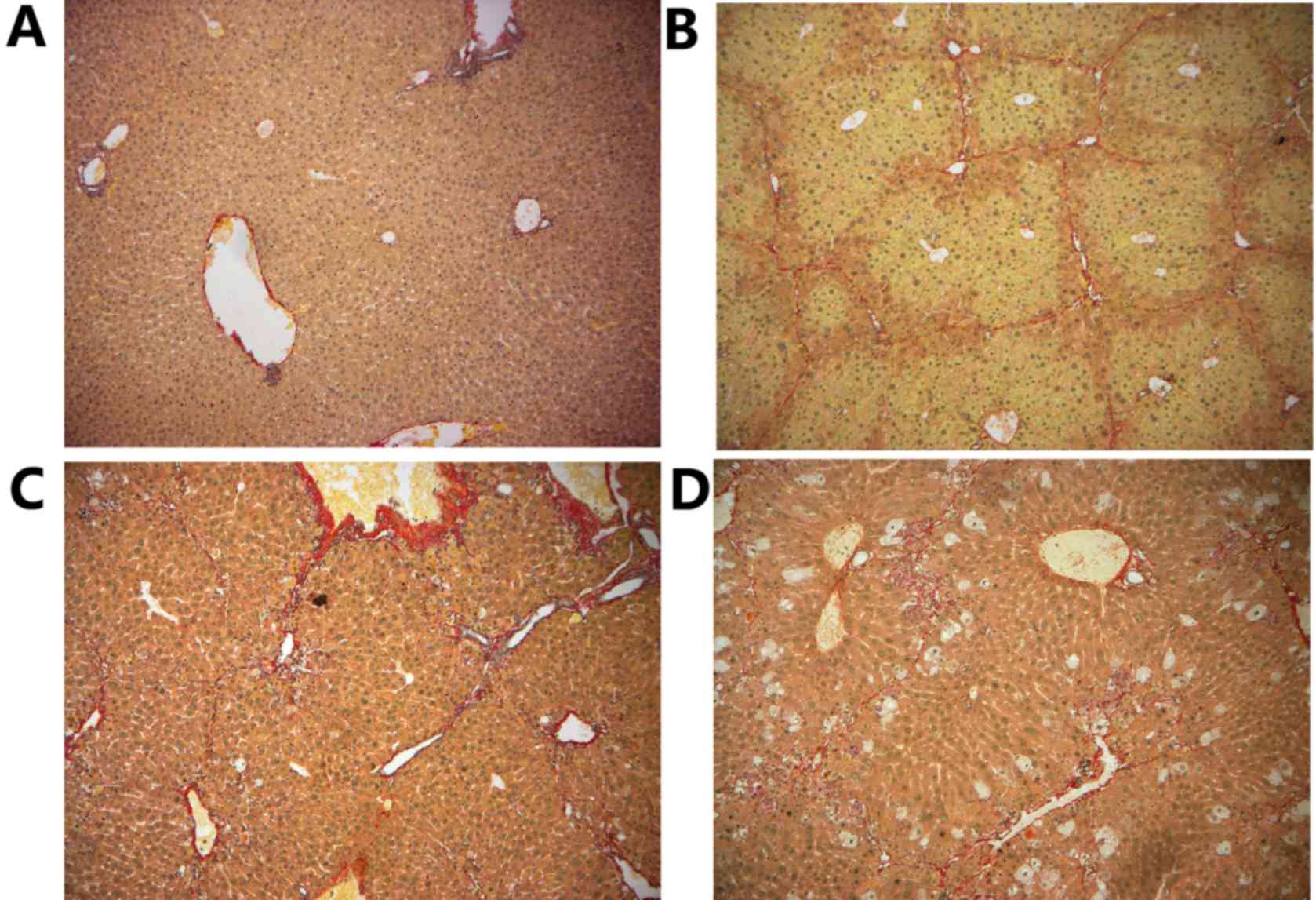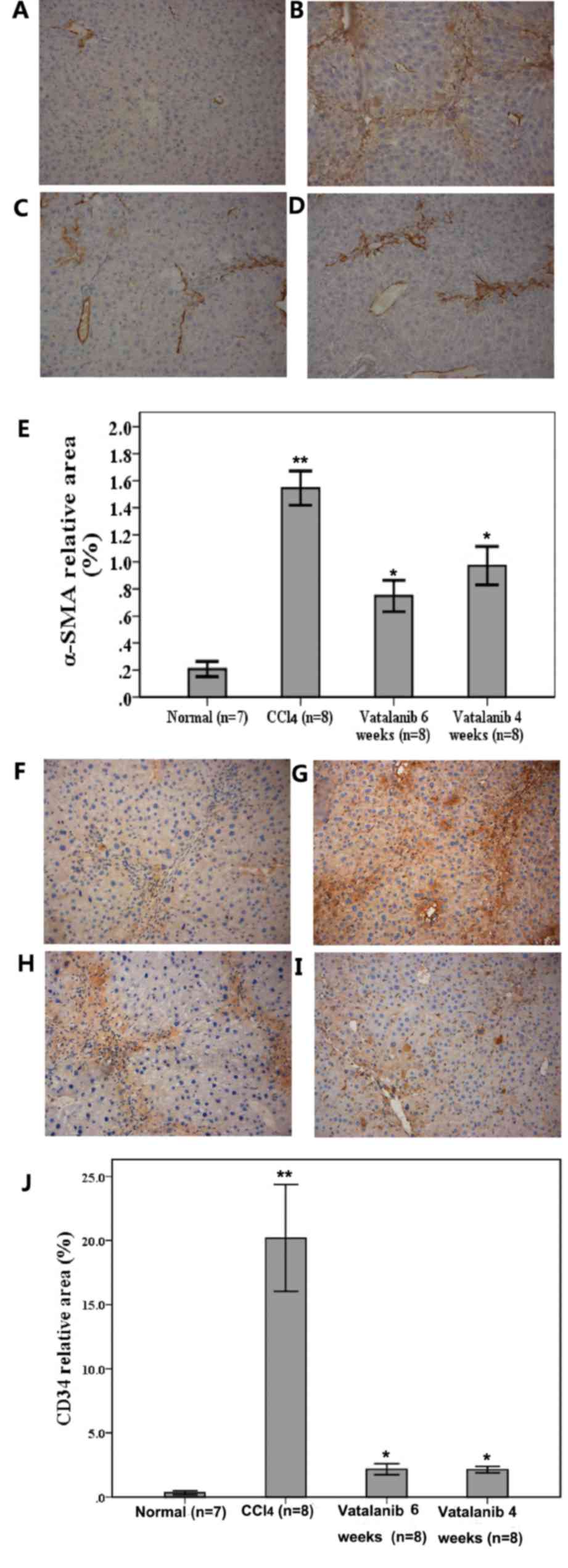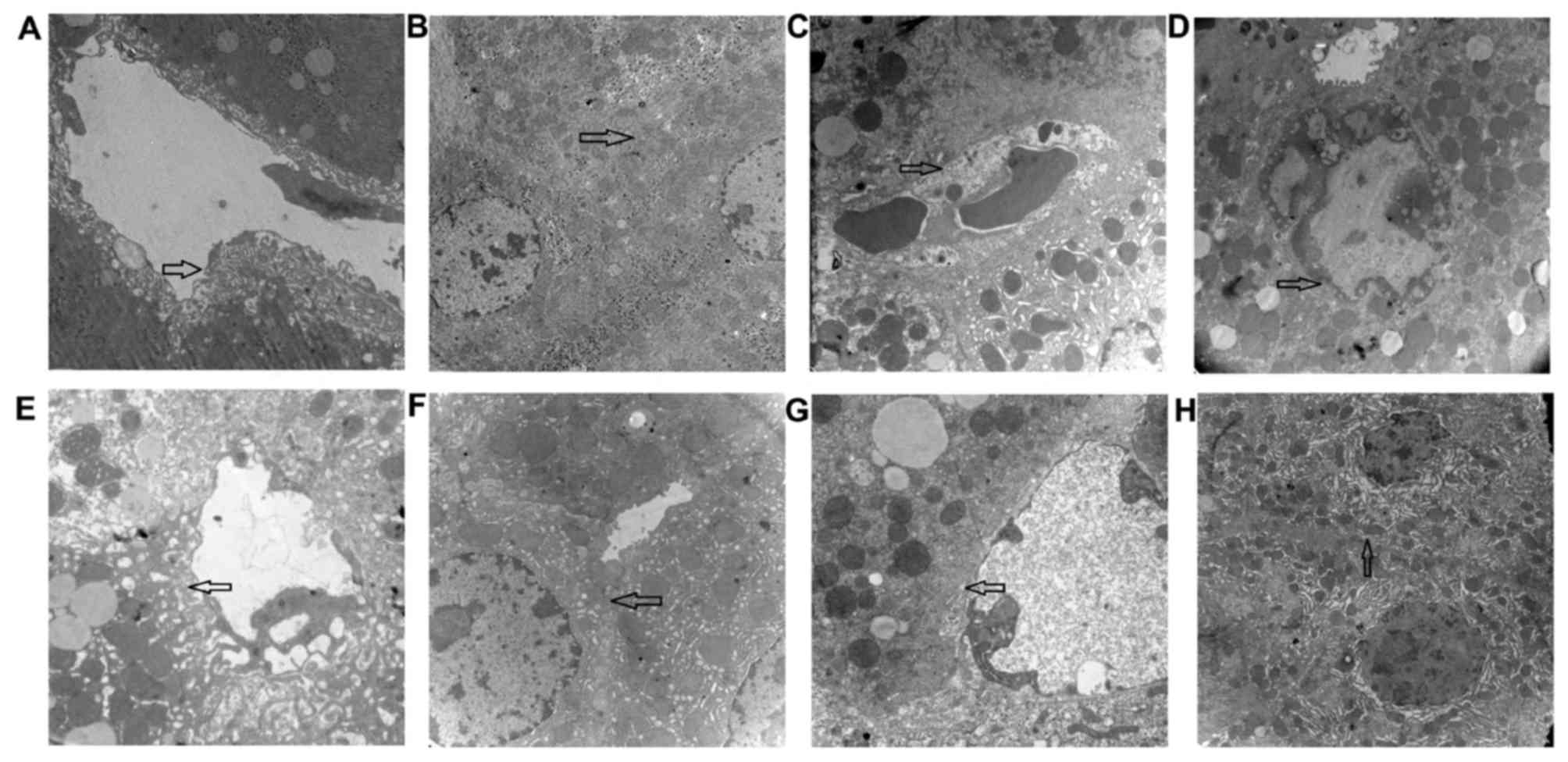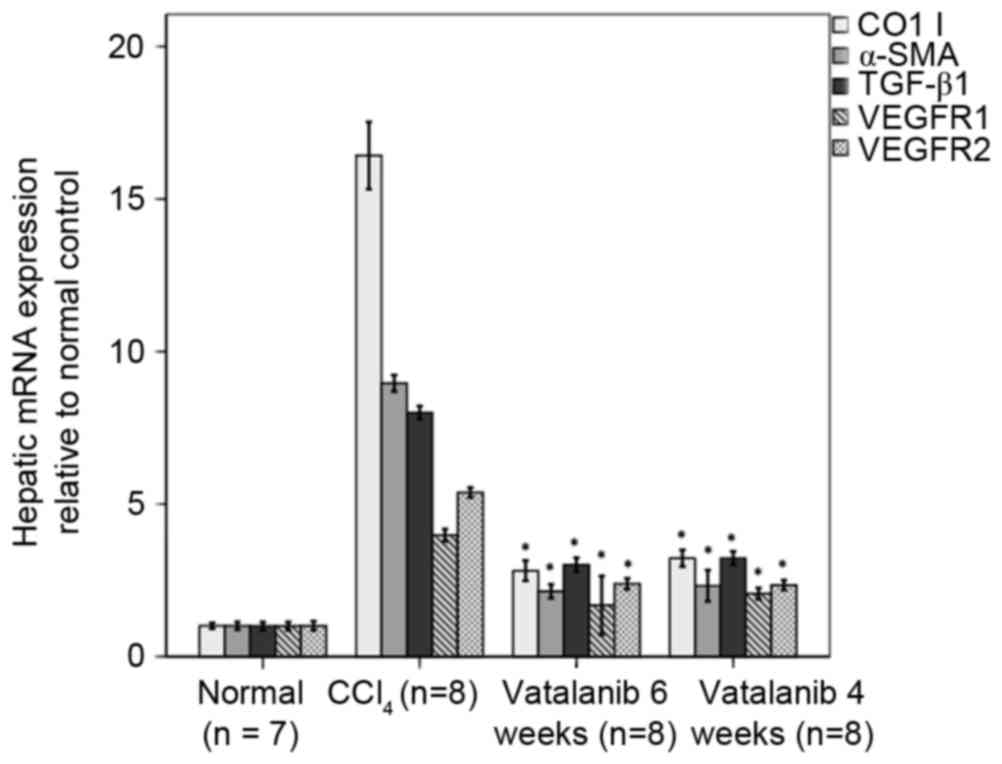|
1
|
Friedman SL: Cellular networks in hepatic
fibrosis. Digestion. 59:368–371. 1998. View Article : Google Scholar : PubMed/NCBI
|
|
2
|
Friedman SL: Hepatic fibrosis-overview.
Toxicology. 254:120–129. 2008. View Article : Google Scholar : PubMed/NCBI
|
|
3
|
Ghiassi-Nejad Z and Friedman SL: Advances
in antifibrotic therapy. Expert Rev Gastroenterol Hepatol.
2:803–816. 2008. View Article : Google Scholar : PubMed/NCBI
|
|
4
|
Jiao J, Friedman SL and Aloman C: Hepatic
fibrosis. Curr Opin Gastroenterol. 25:223–229. 2009. View Article : Google Scholar : PubMed/NCBI
|
|
5
|
Friedman SL: Liver fibrosis: From
mechanisms to treatment. Gastroenterol Clin Biol. 31:812–814. 2007.
View Article : Google Scholar : PubMed/NCBI
|
|
6
|
Friedman SL and Bansal MB: Reversal of
hepatic fibrosis-fact or fantasy? Hepatology. 43:(2 Suppl 1).
S82–S88. 2006. View Article : Google Scholar : PubMed/NCBI
|
|
7
|
Ferrara N and Davis-Smyth T: The biology
of vascular endothelial growth factor. Endocr Rev. 18:4–25. 1997.
View Article : Google Scholar : PubMed/NCBI
|
|
8
|
Coulon S, Heindryckx F, Geerts A, Van
Steenkiste C, Colle I and Van Vlierberghe H: Angiogenesis in
chronic liver disease and its complications. Liver Int. 31:146–162.
2011. View Article : Google Scholar : PubMed/NCBI
|
|
9
|
Fernández M, Semela D, Bruix J, Colle I,
Pinzani M and Bosch J: Angiogenesis in liver disease. J Hepatol.
50:604–620. 2009. View Article : Google Scholar : PubMed/NCBI
|
|
10
|
Lai WK and Adams DH: Angiogenesis and
chronic inflammation; The potential for novel therapeutic
approaches in chronic liver disease. J Hepatol. 42:7–11. 2005.
View Article : Google Scholar : PubMed/NCBI
|
|
11
|
Thabut D and Shah V: Intrahepatic
angiogenesis and sinusoidal remodeling in chronic liver disease:
New targets for the treatment of portal hypertension? J Hepatol.
53:976–980. 2010. View Article : Google Scholar : PubMed/NCBI
|
|
12
|
Mejias M, Garcia-Pras E, Tiani C, Miquel
R, Bosch J and Fernandez M: Beneficial effects of sorafenib on
splanchnic, intrahepatic and portocollateral circulations in portal
hypertensive and cirrhotic rats. Hepatology. 49:1245–1256. 2009.
View Article : Google Scholar : PubMed/NCBI
|
|
13
|
Majumder S, Piguet AC, Dufour JF and
Chatterjee S: Study of the cellular mechanism of Sunitinib mediated
inactivation of activated hepatic stellate cells and its
implications in angiogenesis. Eur J Pharmacol. 705:86–95. 2013.
View Article : Google Scholar : PubMed/NCBI
|
|
14
|
Thabut D, Routray C, Lomberk G, Shergill
U, Glaser K, Huebert R, Patel L, Masyuk T, Blechacz B, Vercnocke A,
et al: Complementary vascular and matrix regulatory pathways
underlie the beneficial mechanism of action of sorafenib in liver
fibrosis. Hepatology. 54:573–585. 2011. View Article : Google Scholar : PubMed/NCBI
|
|
15
|
Chen J, Liu DG, Yang G, Kong LJ, Du YJ,
Wang HY, Li FD, Pei FH, Song JT, Fan YJ, et al: Endostar, a novel
human recombinant endostatin, attenuates liver fibrosis in
CCl4-induced mice. Exp Biol Med (Maywood). 239:998–1006. 2014.
View Article : Google Scholar : PubMed/NCBI
|
|
16
|
Jones SF, Spigel DR, Yardley DA, Thompson
DF and Burris HA III: A phase I trial of vatalanib (PTK/ZK) in
combination with bevacizumab in patients with refractory and/or
advanced malignancies. Clin Adv Hematol Oncol. 9:845–852.
2011.PubMed/NCBI
|
|
17
|
Thomas AL, Morgan B, Drevs J, Unger C,
Wiedenmann B, Vanhoefer U, Laurent D, Dugan M and Steward WP:
Vascular endothelial growth factor receptor tyrosine kinase
inhibitors: PTK787/ZK 222584. Semin Oncol. 30:(3 Suppl 6). S32–S38.
2003. View Article : Google Scholar
|
|
18
|
Yau T, Chan P, Pang R, Ng K, Fan ST and
Poon RT: Phase 1–2 trial of PTK787/ZK222584 combined with
intravenous doxorubicin for treatment of patients with advanced
hepatocellular carcinoma: Implication for antiangiogenic approach
to hepatocellular carcinoma. Cancer. 116:5022–5029. 2010.
View Article : Google Scholar : PubMed/NCBI
|
|
19
|
Yang Y, Jin L, He YL, Wang K, Ma XH, Wang
J, Yan Z, Feng YL, Li YQ, Chen TY, et al: Hepatitis B virus
infection in clustering of infection in families with unfavorable
prognoses in northwest China. J Med Virol. 85:1893–1899. 2013.
View Article : Google Scholar : PubMed/NCBI
|
|
20
|
Liu Y, Lui EL, Friedman SL, Li L, Ye T,
Chen Y, Poon RT, Wo J, Kok TW and Fan ST: PTK787/ZK22258 attenuates
stellate cell activation and hepatic fibrosis in vivo by inhibiting
VEGF signaling. Lab Invest. 89:209–221. 2009. View Article : Google Scholar : PubMed/NCBI
|
|
21
|
Wang H, Zhang Y, Wang T, You H and Jia J:
N-methyl-4-isoleucine cyclosporine attenuates CCl-induced liver
fibrosis in rats by interacting with cyclophilin B and D. J
Gastroenterol Hepatol. 26:558–567. 2011. View Article : Google Scholar : PubMed/NCBI
|
|
22
|
Liu Y, Poon RT, Li Q, Kok TW, Lau C and
Fan ST: Both antiangiogenesis- and angiogenesis-independent effects
are responsible for hepatocellular carcinoma growth arrest by
tyrosine kinase inhibitor PTK787/ZK222584. Cancer Res.
65:3691–3699. 2005. View Article : Google Scholar : PubMed/NCBI
|
|
23
|
Xu H, Shi BM, Lu XF, Liang F, Jin X, Wu TH
and Xu J: Vascular endothelial growth factor attenuates hepatic
sinusoidal capillarization in thioacetamide-induced cirrhotic rats.
World J Gastroenterol. 14:2349–2357. 2008. View Article : Google Scholar : PubMed/NCBI
|
|
24
|
Elpek GÖ, Unal B and Bozova S: H-ras
oncogene expression and angiogenesis in experimental liver
cirrhosis. Gastroenterol Res Pract. 2013:8689162013. View Article : Google Scholar : PubMed/NCBI
|
|
25
|
Livak KJ and Schmittgen TD: Analysis of
relative gene expression data using real-time quantitative PCR and
the 2(−Delta Delta C(T)) method. Methods. 25:402–408. 2001.
View Article : Google Scholar : PubMed/NCBI
|
|
26
|
Medina J, Arroyo AG, Sánchez-Madrid F and
Moreno-Otero R: Angiogenesis in chronic inflammatory liver disease.
Hepatology. 39:1185–1195. 2004. View Article : Google Scholar : PubMed/NCBI
|
|
27
|
Calderone V, Gallego J, Fernandez-Miranda
G, Garcia-Pras E, Maillo C, Berzigotti A, Mejias M, Bava FA,
Angulo-Urarte A, Graupera M, et al: Sequential functions of CPEB1
and CPEB4 regulate pathologic expression of vascular endothelial
growth factor and angiogenesis in chronic liver disease.
Gastroenterology. 150:982–997.e30. 2016. View Article : Google Scholar : PubMed/NCBI
|
|
28
|
Fernandez M, Vizzutti F, Garcia-Pagan JC,
Rodes J and Bosch J: Anti-VEGF receptor-2 monoclonal antibody
prevents portal-systemic collateral vessel formation in portal
hypertensive mice. Gastroenterology. 126:886–894. 2004. View Article : Google Scholar : PubMed/NCBI
|
|
29
|
Schomber T, Zumsteg A, Strittmatter K,
Crnic I, Antoniadis H, Littlewood-Evans A, Wood J and Christofori
G: Differential effects of the vascular endothelial growth factor
receptor inhibitor PTK787/ZK222584 on tumor angiogenesis and tumor
lymphangiogenesis. Mol Cancer Ther. 8:55–63. 2009. View Article : Google Scholar : PubMed/NCBI
|
|
30
|
Kircher SM, Nimeiri HS and Benson AB III:
Targeting angiogenesis in colorectal cancer: Tyrosine kinase
inhibitors. Cancer J. 22:182–189. 2016. View Article : Google Scholar : PubMed/NCBI
|
|
31
|
Dragovich T, Laheru D, Dayyani F, Bolejack
V, Smith L, Seng J, Burris H, Rosen P, Hidalgo M, Ritch P, et al:
Phase II trial of vatalanib in patients with advanced or metastatic
pancreatic adenocarcinoma after first-line gemcitabine therapy
(PCRT O4-001). Cancer Chemother Pharmacol. 74:379–387. 2014.
View Article : Google Scholar : PubMed/NCBI
|
|
32
|
Langenberg MH, Witteveen PO, Lankheet NA,
Roodhart JM, Rosing H, van den Heuvel IJ, Beijnen JH and Voest EE:
Phase 1 study of combination treatment with PTK 787/ZK 222584 and
cetuximab for patients with advanced solid tumors: Safety,
pharmacokinetics, pharmacodynamics analysis. Neoplasia. 12:206–213.
2010. View Article : Google Scholar : PubMed/NCBI
|
|
33
|
Vanheule E, Geerts AM, Van Huysse J,
Schelfhout D, Praet M, Van Vlierberghe H, De Vos M and Colle I: An
intravital microscopic study of the hepatic microcirculation in
cirrhotic mice models: Relationship between fibrosis and
angiogenesis. Int J Exp Pathol. 89:419–432. 2008. View Article : Google Scholar : PubMed/NCBI
|
|
34
|
Ferrara N and Kerbel RS: Angiogenesis as a
therapeutic target. Nature. 438:967–974. 2005. View Article : Google Scholar : PubMed/NCBI
|
|
35
|
Liu Y, Wen XM, Lui EL, Friedman SL, Cui W,
Ho NP, Li L, Ye T, Fan ST and Zhang H: Therapeutic targeting of the
PDGF and TGF-beta-signaling pathways in hepatic stellate cells by
PTK787/ZK22258. Lab Invest. 89:1152–1160. 2009. View Article : Google Scholar : PubMed/NCBI
|
|
36
|
Braet F and Wisse E: Structural and
functional aspects of liver sinusoidal endothelial cell fenestrae:
A review. Comp Hepatol. 1:12002. View Article : Google Scholar : PubMed/NCBI
|
|
37
|
Huebert RC, Jagavelu K, Liebl AF, Huang
BQ, Splinter PL, LaRusso NF, Urrutia RA and Shah VH: Immortalized
liver endothelial cells: A cell culture model for studies of
motility and angiogenesis. Lab Invest. 90:1770–1781. 2010.
View Article : Google Scholar : PubMed/NCBI
|
|
38
|
Friedman SL: Preface. Hepatic fibrosis:
Pathogenesis, diagnosis and emerging therapies. Clin Liver Dis.
12:xiii–xiv. 2008. View Article : Google Scholar : PubMed/NCBI
|


















